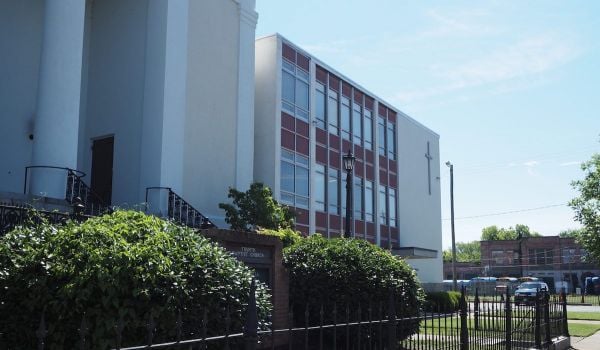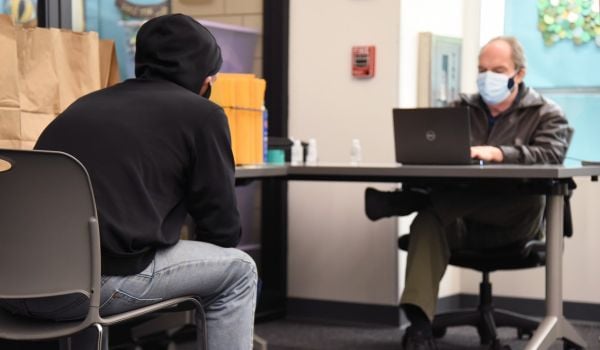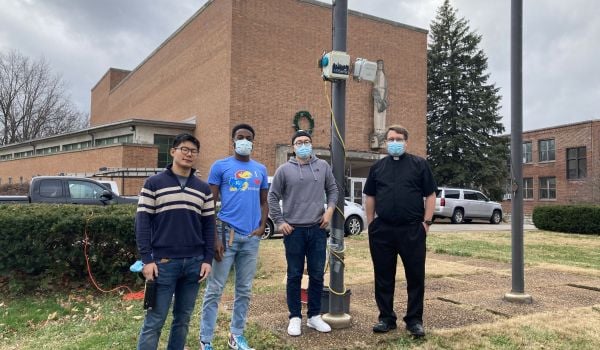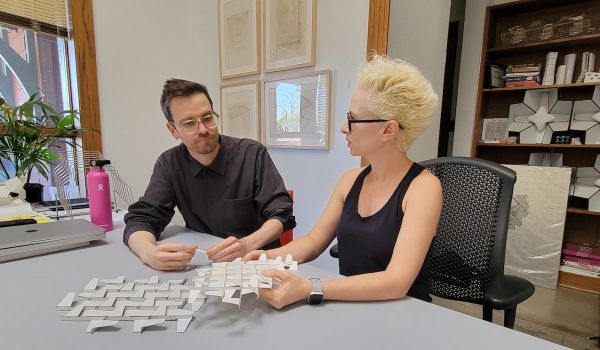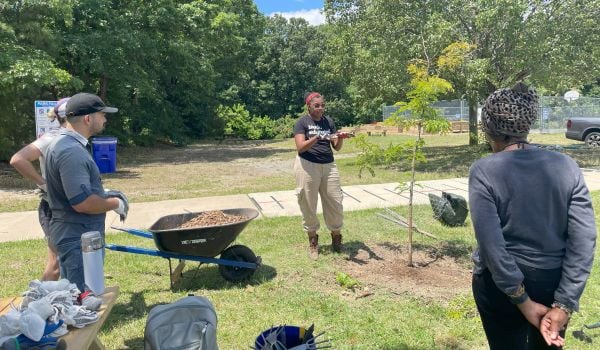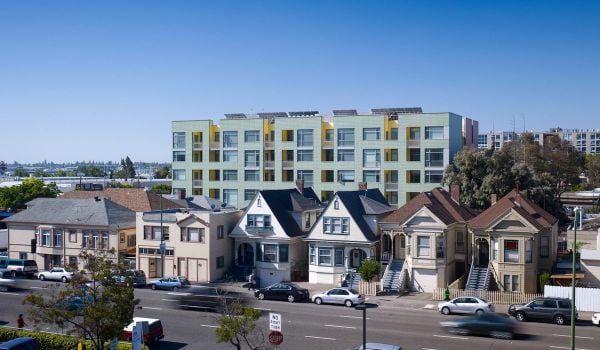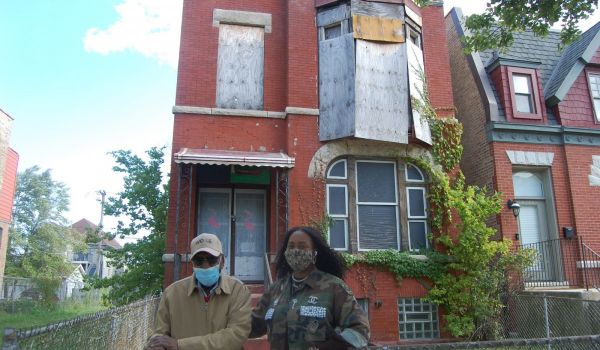Last Friday was the sort of day preservationists in St. Louis, Mo. had only ever dreamed about. As the sun started breaking through the cloud-gray morning sky, a Starbucks coffee shop opened its doors inside a renovated space-age concrete gas station at Grand and Forest Park boulevards, the subject to an intense demolition threat just one year prior. By the end of the day, the St. Louis Post-Dispatch broke the news that another chain, drug store CVS, was backing off its plans to demolish the elliptical mid-century modern AAA Building in Midtown. Within a few hours, months of protest ended in celebration.
Now the city will retain two of its strangest and most recognizable mid-century modern buildings. The gas station housing Starbucks was built as a Phillips 66 station at the corner of a federally financed, Teamster-built housing project called Council Plaza, which consists of two slab high rises, a two-story commercial building and the gas station (all now listed in the National Register of Historic Places).
The gas station, which later became a Del Taco restaurant, essentially consists of four tapered columns supporting a hyperbolic paraboloid, or tapered round roof — hence the nickname “flying saucer.” Richard Henmi served as project architect on the saucer for the firm Schwarz & Van Hoefen, and the gas station was completed in 1967. Now retired, Henmi was able to fight for its preservation and see its adaptive reuse.
The other building now spared is another example of auto-centric modernism, showing that St. Louis preservationists have embraced complicated buildings of the recent past. The AAA Building is elliptical in form, mirroring the AAA logo, and consists of a projecting roof above a colonnade of tapered columns. Designed by renowned bank architect Wenceslao Sarmiento and completed in 1976, the building’s updated classicism puts it at the forefront of the New Formalism prevalent at the time. The interior consists of large open lobby in the form of the building, punctuated by strikingly decorated columns. Sarmiento turned 90 on the day that the preservation of his building, which has not changed much since opening, became public.
Both preservation victories arrived after long battles, fought in an emergent coalition of architecture enthusiasts, concerned residents and elected officials. The successes represent a change from earlier efforts that included many of the same parties. In 2009, the ad hoc Friends of the San Luis unsuccessfully fought the Archdiocese of St. Louis, which demolished the modernist San Luis Apartments (originally the DeVille Motor Hotel), a concrete-clad work by New Orleans architect Charles Colbert, to create a surface parking lot in the Central West End.
Yet the Friends of the San Luis earned attention for use of social media, non-protest educational events and traditional tactics, like turning out public testimony at the Preservation Board (20 citizens testified against demolition at the meeting in June 2009) and a lawsuit seeking injunction against demolition (it failed). The group suggested ways to educate the public on sometimes-confusing issues of architectural style and the details of preservation law, as well as successful tactics for convincing officials that preservationists actually make up a voter bloc. Although the San Luis fell, the city saw that there was a movement for preserving worthy buildings and enforcing the city’s preservation and planning laws against anti-urban proposals.
When developer Rick Yackey had Alderwoman Marlene Davis introduce a blighting bill that exempted the “flying saucer” from mandatory demolition review last June, he likely didn’t anticipate much attention. Yackey, who had been renovating other buildings at Council Plaza using historic tax credits, sought both blighting and tax increment financing to demolish the building for a new retail structure. He did not foresee a quick tweet from reporter Tim Logan (author of an upcoming Forefront story on preservation issues in St. Louis) leading to widespread opposition to his plans. Within a day there was a “Save the St. Louis Del Taco” Facebook page that received over 12,000 likes. Preservationist bloggers were writing away, joined by advocacy organizations Modern STL, Landmarks Association of St. Louis and Missouri Preservation.
Gallery: Del Taco Saucer / AAA Building, St. Louis
These groups had members burning the virtual ears of Davis and Mayor Francis Slay with emails. The mayor stated that he would veto a bill that did not include demolition review for the flying saucer. Then 31-year-old Alderman Shane Cohn, in his first term, succeeded in amending Davis’ bill to require that the city’s Cultural Resources Office review any demolition permit for the flying saucer.
Upon passage of his bills, Yackey surprised many when he announced he would rehabilitate the flying saucer using historic tax credits. He cited public concern as his reason, and was blunt about being reluctant to rehabilitate a structure he did not find very profitable. Yet he acted voluntarily, ending the battle.
That left preservationists busy with a proposal that emerged during the summer. CVS had been seeking a site near an existing Walgreens on Lindell Boulevard, and began negotiating with the AAA to purchase the site of the elliptical building. By July 2011, CVS seemed poised to purchase and demolish the late modern landmark for a one-story store surrounded by surface parking. AAA would relocate in a small building on the site.
Again, advocates jumped into place. However, the newer and less visible AAA Building did not inspire the same sort of huge public protest as did the Del Taco spaceship. Most importantly, the AAA Building stood outside of the demolition review authority of the Cultural Resources Office. In the voluntary ward-by-ward review system St. Louis has, the structure was in the 18th Ward, which lacked review. Without owner consent, a listing in the National Register that would trigger demolition review was impossible.
Alderman Terry Kennedy remedied the situation by introducing legislation early this year that added several blocks to demolition review, including the site of the AAA Building. Upon enactment this summer, AAA and CVS took the demolition to the city’s Preservation Board for preliminary review in June. Cultural Resources Office Director Betsy Bradley strongly recommended denial of demolition, and stated that although the AAA Building was only 46 years old, its association with Sarmiento and its significant design made it eligible for city landmark status. The Preservation Board denied demolition unanimously.
No additional news came until last week. AAA told the press that it would remain in its building, and that CVS was buying its lot and garage next door for the purpose of constructing a two-story building to be built on the sidewalk line. The proposal was strangely similar to hypothetical models offered by architects John Wimmer and Jeremy Claggett on their blog What Should Be and by architect and preservationist Paul Hohmann at Vanishing STL. Not only did the outcome seem crowd-sourced, but the design solution as well.

Michael R. Allen is the founder and director of the Preservation Research Office and a lecturer in American Culture Studies at Washington University in St. Louis. His writing on historic preservation, architectural history and public art has appeared in the St. Louis Post-Dispatch, Temporary Art Review, PreservationNation, nextSTL and other outlets.










